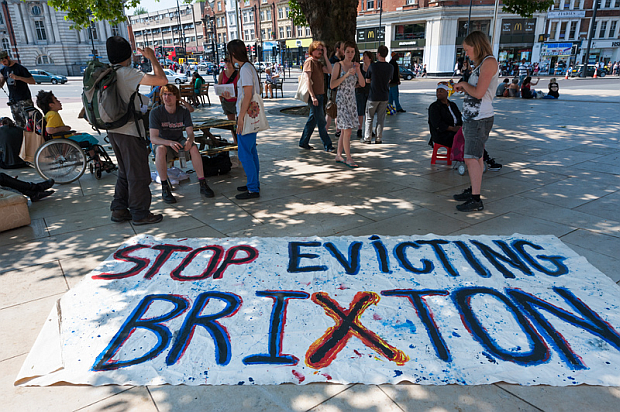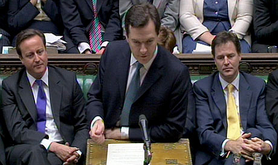
Banner at anti-eviction protest in Brixton, 2013. Peter Marshall, Demotix.
Gentrification, a word so often used, but so difficult to define. This year is its 50th birthday, and it is more bloated than ever. The term originated as an aside, a bit of a joke, it developed as a description of a quite specific set of neighbourhood dynamics, and ultimately became an all encompassing brand for the study of changing neighbourhoods in cities across the word.
It is confusing, and can serve as a distraction both from the structural forces transforming cities throughout the world, and the often harmful effects on the lives of city-dwellers. Yet, colloquially gentrification remains a term that carries a great deal of force and it would be churlish to dismiss a term that is at the heart of many local struggles over neighbourhood change in cities throughout the world. But if we don’t recognise that it is just a conceptual shell to contain the destructive effects of the property market in cities, then we run the risk of drawing battle lines for a fight that can never be won. If gentrification is going to continue to be a useful way of understanding urban change, we must begin to see it as a colloquial, not analytical, term.
Ruth Glass’ maiden name was Lazarus, and perhaps inevitably the term she coined has refused to die out. She seems to have used it only once in print, in a brilliant piece of writing on London introducing a collection of articles titled London; Aspects of Change, in 1964. She spoke specifically, but briefly about the invasion and refurbishment of working class neighbourhoods by the middle classes: “shabby modest mews” transformed into “elegant, expensive residences”; the kind of gentrification carried out by those Alan Bennett would later call “knocker[s] through”.
Interestingly it was nearly ten years before the academy started to pay heed to gentrification with any rigour. Chris Hamnett, now professor at King’s College London, published the first empirical analysis of ‘gentrification’ in 1973. He spoke very specifically about neighbourhoods in London where this kind of refurbishment was being undertaken by the middle classes. A response by peers didn’t seem to know what to call it at all, referring to “Gentrification, Chelseafication, or whatever term is employed”[1]. In its early use the phenomena was geographically bounded and tightly defined, but the term used to describe it was far less certain - in the years since this has of course reversed.
In 1979, Neil Smith, as a callow youth, formulated the rent gap hypothesis. Smith’s landmark contribution transformed our understanding of the term, from one which referred to specific neighbourhood contexts, to a broader theory of the way in which capital behaves in the city. In the years following its publication it came to represent the production side of the debate - that gentrification is a consequence of economic superstructure rather than the cultural choices made by so-called gentrifiers. It is this hypothesis which has been at the centre of the maelstrom of debate that has unfortunately characterised the field of gentrification scholarship.
Even within
the first decade of gentrification scholarship the term was beginning to
fracture. In 1984 Damaris Rose was already calling the term a “chaotic
conception” that obscures the “multiplicity of processes” causing neighbourhood change. And today the
mutation and expansion of gentrification’s use in an academic context has
continued apace.
In 1999 Liz Bondi would write that: "the more researchers have
attempted to pin it down the more burdens the concept has had to carry. Maybe
the loss of momentum around gentrification reflects its inability to open up
new insights, and maybe it is time to disintegrate under the weight of these burdens"
In London, the original dynamics that the term described are long gone, the opportunities for the young bourgeois to buy up dilapidated housing stock to return to its former glory are not there in the same way they used to be, indeed it is far more likely that buy-to-let landlords are in control of the market in gentrifying neighbourhoods. Instead of the refurbishment grants and council housing of the seventies, help-to-buy and housing benefit are how today’s neo-liberal state intervenes in the market.
From Hebden Bridge to Harlem academics and local residents talk about changes in their neighbourhood as “gentrification”. This gives an idea of a false unity, as if Mumbai and Malmo are experiencing change that is somehow equivalent. Yet it is true to say that these places hold something in common, not to be found in any kind of ethereal taxonomy of gentrification but rather in a common experience of the adverse effects of capital on the social conditions in the city.
Gentrification scholars still seem to be clinging onto the term, though the field is losing some of the momentum that it once had. From ‘rural-gentrification’, and ‘new-build gentrification’, to the bombastic ‘super-gentrification’ the explosion in taxonomy, reflects a somewhat desperate need to maintain the term.
Whilst recent interventions to re-emphasise the importance of displacement in gentrification are important, any attempt by academics to demarcate the boundaries of what is and isn’t gentrification is a kind of intellectual imperialism. And of course the most often neglected, and most important voice, is the voice of people who are suffering the ill-effects of the property market in cities across the world. While both Academia and the Media are obsessed with yuppies and refurbished houses - they both fail to engage with these changes in their full complexity. In any area where residents feel under attack they will be using a word like gentrification, it is not the job of a researcher or anyone else for that matter, to impose a formal definition of what gentrification means on a neighbourhood.
If we are not to dispose of the word in its entirety, we should adopt its colloquial usage. Any debate over what does and does not constitute gentrification becomes moot when faced with the rage and emotion felt by those involved in anti-gentrification struggles in specific neighbourhoods. Does the destruction of the Heygate Estate (see here, here and here)‘count’ as gentrification? Does eachnew restaurant mean an increase in rent? Does a Google shuttle bus make displacement inevitable? Is rural gentrification a thing? Who cares? The point is that people who live in these neighbourhoods are angry, and gentrification can be a word for what they are angry at - and nobody outside these places has the right to question that. My own research focuses on Brixton, I could spend four years quibbling as to what stage in one or other codification of gentrification the area is at, or whether I subscribe to a production or consumption model based on quantitative and economic research. Or I could spend time in Brixton and meet people, and learn directly what it means to live in a neighbourhood undergoing gentrification.
Having said that, while we should respect the way that gentrification is defined at street level, this must not be done uncritically. At its worst the word gentrification means that those concerned with social conditions in cities across the world are fighting on an isolated front. Neighbourhood change does not occur on a single front as implied by the term gentrification. To classify is to tidy up, and in doing so the turbulent process of urban change will be lost to us. Ruth Glass knew very well the dangers of classification. Only two years after London Aspects of Change was published, in an essay on urban conflict, she wrote: “It is especially tempting to begin with some kind of classification. But there is also a risk that the beginning may also be the end.”
A more critical engagement with the term gentrification may indeed facilitate more productive discussions between the academy, local residents and activists, and policy makers. In directly engaging with gentrification as experienced, I hope that the hard felt emotional responses to changing neighbourhoods might be channeled away from the Quixotic windmill that gentrification has become, and towards the real and violent forces of capitalism in our cities. Too often the word gentrification makes people hate fancy coffee, moustaches (full disclosure, I have one) and yuppies, when they should also be hating their government, landlords and the financialization of the property market.
For more articles on the series go to the Cities in Conflict mainpage.
[1] Dugmore, Keith, and Peter Williams. “Improvement Grants.” Area 6, no. 2 (January 1, 1974): 159–160. p. 159
Read more
Get our weekly email





Comments
We encourage anyone to comment, please consult the oD commenting guidelines if you have any questions.